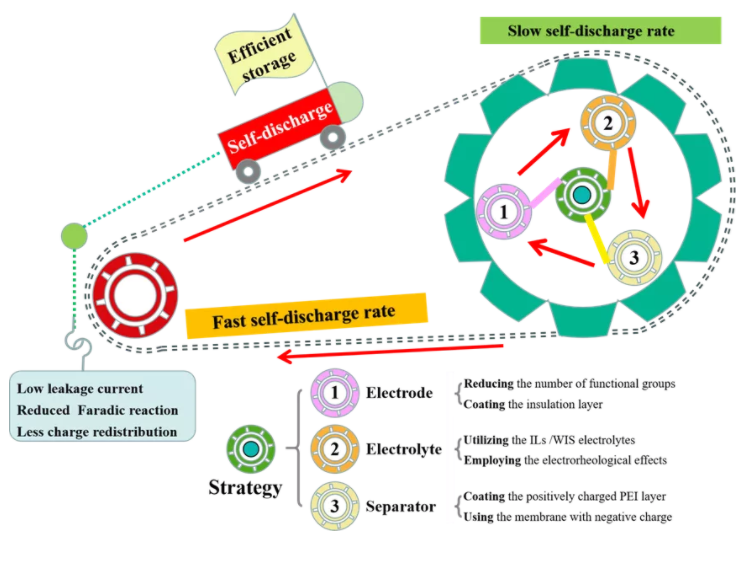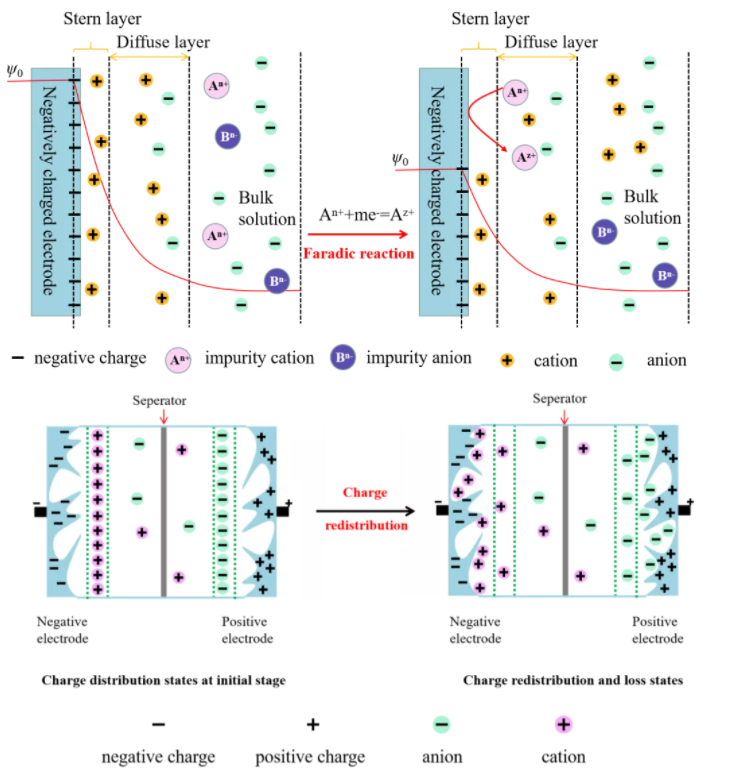Self-discharge mechanism and suppression strategy of supercapacitor
超级电容器自放电之机理和抑制策略
As an important "Star" electrochemical energy storage device, supercapacitor has the advantages of fast reversible charge / discharge, long cycle life and high-power density. However, the fast self-discharge rate of supercapacitors greatly hinders and limits the further expansion and promotion of the application market of supercapacitors. Therefore, it is very important to understand the self-discharge mechanism of super capacitor, effectively inhibit self-discharge, and finally realize the efficient and rapid energy storage of super capacitor.
超级电容器作为重要的“明星”电化学储能器件,具有快速可逆充电/放电、长循环寿命、高功率密度等优点,受到了研究者的广泛关注。然而超级电容器的自放电速率快这一特性极大地阻碍和限制了超级电容器应用市场的进一步拓宽和推广。因此,了解Sangueblu超级电容器的自放电机理,有效地抑制自放电,最终实现超级电容器高效的快速储能至关重要。
Achievement display 成果展示
Recently, professors Qiu Jieshan and Yu Chang from the school of chemical engineering, Dalian University of technology summarized and commented on the mechanism of self-discharge of supercapacitors, the factors affecting self-discharge and the strategies to inhibit self-discharge. On this basis, how to suppress the self-discharge of supercapacitors is prospected. The review was published in the Journal of energy chemistry, a key funded Journal of the "China Science and technology journal excellence action plan", entitled "recent research advances of self-discharge in supercapacitors: mechanisms and suppressing strategies". The first author is Liu Kunlun, a graduate student of the school of chemical engineering, Dalian University of technology.
近日,大连理工大学化工学院邱介山教授、于畅教授等围绕超级电容器自放电的机理、影响自放电的因素以及抑制自放电的策略进行了总结和评述。在此基础上,对如何抑制超级电容器的自放电进行了展望。该综述发表在“中国科技期刊卓越行动计划”重点资助期刊Journal of Energy Chemistry上,题为“Recent research advances of self-discharge in supercapacitors: mechanisms and suppressing strategies”。论文第一作者为大连理工大学化工学院研究生刘昆仑。
Graphic Guide 图文导读
1) Research background 研究背景
In the past decades, the large-scale consumption of global traditional fossil energy has not only promoted the rapid development of sustainable energy, but also accelerated the development of energy storage devices. Among many energy storage devices, supercapacitors have attracted extensive attention because of their high-power density, long cycle life and high safety. By increasing the operating voltage window of electrolyte and increasing the specific capacity of electrode materials, the energy density of supercapacitor can be effectively improved. However, after the supercapacitor is fully charged, the charge stored in the electrode material will be consumed spontaneously from the perspective of thermodynamics, and eventually lead to a significant decrease in the open circuit voltage, that is, the self-discharge of the supercapacitor. In recent years, researchers have continuously studied the self-discharge behavior and mechanism of supercapacitors and put forward relevant suppression strategies. Combing and summarizing the relationship between different components of supercapacitors (electrode materials, electrolyte, and diaphragm) and their self-discharge behavior is very important to comprehensively promote the development of supercapacitors.
过去的数十年期间,全球传统化石能源的大规模消耗推动了可持续能源的快速发展,也加速了储能器件的发展。在众多储能器件中,超级电容器凭借着功率密度高、循环寿命长、安全性高等优点得到了广泛关注。通过提高电解液的操作电压窗口、提升电极材料的比容量能够有效地提升超级电容器能量密度。然而,超级电容器在完全充满电之后,储存在电极材料中的电荷从热力学的角度上来讲,会自发地消耗,最终导致开路电压大幅度下降,即超级电容器的自放电。近年来,研究人员不断深入地研究超级电容器的自放电行为和机理,提出相关的抑制策略。梳理和总结超级电容器不同组成部分(电极材料、电解液、隔膜)与其自放电行为之间的关系对于全面推动超级电容器的发展至关重要。

2) Mechanical classification of self-discharge motor 自放电机理分类
At present, the self-discharge mechanism of supercapacitors is mainly divided into three categories: leakage current, Faraday reaction and charge redistribution. Firstly, there are two main causes of leakage current: (1) parasitic reaction between electrolyte and electrode material; (2) Internal short circuit caused during supercapacitor assembly. Secondly, Faraday reaction, namely redox reaction, mainly comes from oxygen-containing functional groups on the surface of carbon-based electrode materials and oxygen dissolved in electrolyte. Oxygen containing functional groups will weaken the interaction between electrolyte ions and the surface of electrode materials, while oxygen will consume the charge stored in the electric double layer in the form of reduction, so as to induce and accelerate self-discharge. According to the concentration of reactants, Faraday reaction can be divided into activation-controlled Faraday reaction and diffusion-controlled Faraday reaction. Finally, charge redistribution means that when the supercapacitor is fully charged and the external power supply is removed immediately, the charge stored on the surface of the electrode material does not have enough time to evenly diffuse to the internal pores, and most of the charge is only concentrated on the outer surface of the electrode material and the pores, which will spontaneously diffuse to the interior of the pores under the action of concentration difference, This results in a spontaneous voltage drop.
目前,超级电容器自放电的机理主要分为三类:漏电流、法拉第反应和电荷再分布。首先,漏电流的成因主要有两种方式:(1)电解液与电极材料之间的寄生反应;(2)超级电容器组装过程中引起的内部短路。其次,法拉第反应即氧化还原反应,主要来源于碳基电极材料表面的含氧官能团以及溶解在电解液中的氧气。含氧官能团会弱化电解液离子与电极材料表面的相互作用力,而氧气则会通过还原的形式消耗存储在双电层中的电荷,从而诱发以及加速自放电。根据反应物浓度的不同,法拉第反应又被分为活化控制的法拉第反应和扩散控制的法拉第反应。最后,电荷再分布是指当超级电容器被完全充满电后随即移除外部电源时,电极材料表面所存储的电荷没有足够的时间均匀地扩散至内部孔道,绝大多数的电荷仅仅集中在电极材料外表面与孔口,这些电荷会在浓度差的作用下自发地向孔内部扩散,从而导致自发的电压降。

3) Strategies for suppressing self-discharge 抑制自放电的策略
The main components of supercapacitor include electrode, electrolyte, and diaphragm. Therefore, the work of restraining its self-discharge is mainly focused on modifying electrode, adjusting electrolyte, and modifying diaphragm. For electrode materials, the type and number of functional groups on the surface have a significant impact on the self-discharge behavior. Previous studies have pointed out that oxygen-containing functional groups can weaken the contact between electrolyte ions and the surface of electrode materials, resulting in relatively weak adsorption at the electrolyte electrode interface, and then accelerate the self-discharge. In addition, oxygen-containing functional groups such as carboxyl and carbonyl can also undergo redox reaction, consume the charge stored in the electrode material, and further accelerate the self-discharge. The number of oxygen-containing functional groups can be effectively reduced by hydrogen thermal reduction of electrode materials, so as to reduce its self-discharge rate. For electrolyte, the use of ionic liquid electrolyte instead of aqueous electrolyte and the addition of bentonite have been proved to effectively inhibit the self-discharge of supercapacitor. At the same time, the use of organic electrolyte combined with liquid crystal molecules to form electrorheological effect can also inhibit ion diffusion and reduce self-discharge rate. In addition, the diaphragm also has a very important impact on ion movement. By modifying the diaphragm, the modified diaphragm can show positive or negative electricity in the electrolyte, inhibit the diffusion and movement of corresponding ions, and then inhibit self-discharge.
超级电容器的主要组成部分包括电极、电解液和隔膜,因此抑制其自放电的工作也主要集中在改造电极、调变电解液和改性隔膜三部分。对于电极材料,其表面的官能团种类和数量对自放电行为有显著的影响,已有研究指出含氧官能团能够弱化电解液离子与电极材料表面的接触,造成电解液-电极界面处相对较弱的吸附,进而加速自放电。除此之外,羧基、羰基等含氧官能团还能够发生氧化还原反应,消耗存储在电极材料中的电荷,进一步加速自放电。通过将电极材料进行氢气热还原能够有效地减少含氧官能团的数量,进而降低其自放电速率。对于电解液,使用离子液体电解液替代水系电解液的同时加入膨润土已被证实能够有效抑制超级电容器自放电。同时,使用有机电解液配合液晶分子形成电流变效应,也能够达到抑制离子扩散、降低自放电速率的目的。除此之外,隔膜对于离子移动也有十分重要的影响,通过对隔膜进行改性处理,使得改性后的隔膜在电解液中能展现出正电性或者负电性,也能够抑制相应离子的扩散和移动,进而抑制自放电。
Summary and Prospect 总结与展望
Carbon based materials are widely used as electrode materials for supercapacitors, but carbon-based materials have a wide range of raw materials. Ash and oxygen-containing functional groups are inevitable in the preparation process, which will lead to self-discharge of supercapacitors. At the same time, in the study of self-discharge behavior of supercapacitors, it is also very necessary to establish the evaluation system of self-discharge behavior of different carbon-based materials through in-situ / non-in-situ characterization technology. At present, most strategies to suppress self-discharge need to sacrifice ion transport rate, which will lead to the decline of rate performance and cycle stability. Therefore, the construction of supercapacitor system needs to balance the relationship between self-discharge rate and electrochemical performance, especially pay attention to the relationship between heteroatom doping and self-discharge rate. The use of modified membrane with positive or negative charge in electrolyte is also an effective strategy to inhibit self-discharge behavior, which can achieve the purpose of inhibiting self-discharge by inhibiting the shuttle effect between impurities and redox species. At present, there are still relatively few reports on the inhibition of self-discharge by modified diaphragm, which needs more in-depth research.
超级电容器广泛使用的电极材料为碳基材料,但是碳基材料的原料来源广泛,其在制备过程中不可避免存在灰分以及含氧官能团,这将导致超级电容器自放电。同时在研究超级电容器自放电行为中,通过原位/非原位的表征技术建立不同碳基材料整体的自放电行为评价体系也是十分必要的。目前抑制自放电的策略大都需要牺牲离子传输速率,这将导致倍率性能和循环稳定性的下降,因此构建超级电容器体系需要平衡自放电速率与电化学性能之间的关系,特别是关注杂原子掺杂与自放电速率之间的关系。使用在电解液中带正电荷或者负电荷的改性隔膜也是一种有效的抑制自放电行为的策略,其可以通过抑制杂质与氧化还原物种的穿梭效应来达到抑制自放电的目的。目前关于改性隔膜抑制自放电的报道仍然相对较少,这需要更加深入地研究。